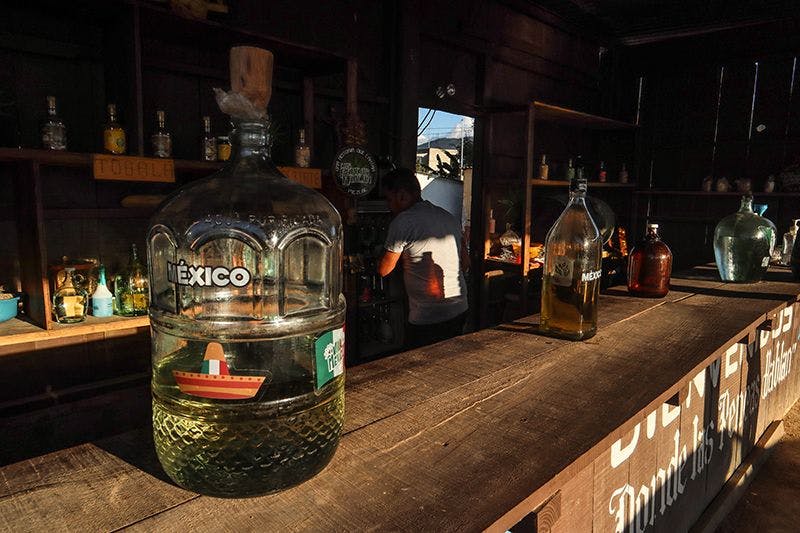January 30, 2021
•
5 min read
Guide to Oaxaca City
Oaxaca City is known for its rich cultural heritage in the form of architecture, cuisine, archaeological sites, and a thriving indigenous culture that is still a remarkable part of its contemporary vibe. In this guide, we will endeavor to explore all these facets.
Rafael Bracho
Insurance Expert
Oaxaca City is known for its rich cultural heritage in the form of architecture, cuisine, archaeological sites, and a thriving indigenous culture that is still a remarkable part of its contemporary vibe. In this guide, we will endeavor to explore all these facets.
Introduction
Guide to Oaxaca City
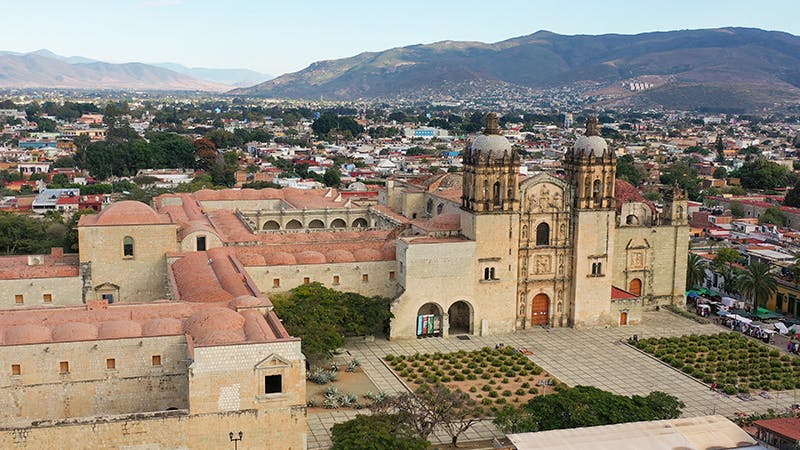 Oaxaca city is located in the center of the state at the base of el Cerro del Fortín where it meets the Atoyac River. This city is the capital of the Mexican state of Oaxaca. Upon his death in 1872, Oaxaca City changed its name to Oaxaca de Juárez to honor the life of famed Mexican president Benito Juárez who was from the state of Oaxaca.
Oaxaca city is located in the center of the state at the base of el Cerro del Fortín where it meets the Atoyac River. This city is the capital of the Mexican state of Oaxaca. Upon his death in 1872, Oaxaca City changed its name to Oaxaca de Juárez to honor the life of famed Mexican president Benito Juárez who was from the state of Oaxaca.
Oaxaca City the largest city in the state. The city has a population of roughly 300,000 people, and the greater metropolitan area has a population of 650,000 people (as of 2014). Oaxaca City is 33 square miles (85 kilometers squared), and it’s rather high in altitude, sitting at 1,555 meters above sea level (5,102 feet).
In 1987, Oaxaca City was designated a UNESCO World Heritage Site, together with the nearby archaeological site of Monte Albán for its outstanding cultural importance. Oaxaca City was isolated from much of Mexico until 1994 when the Oaxaca - Mexico City Highway was built. This isolation allowed for the preservation of much of their native culture.
History
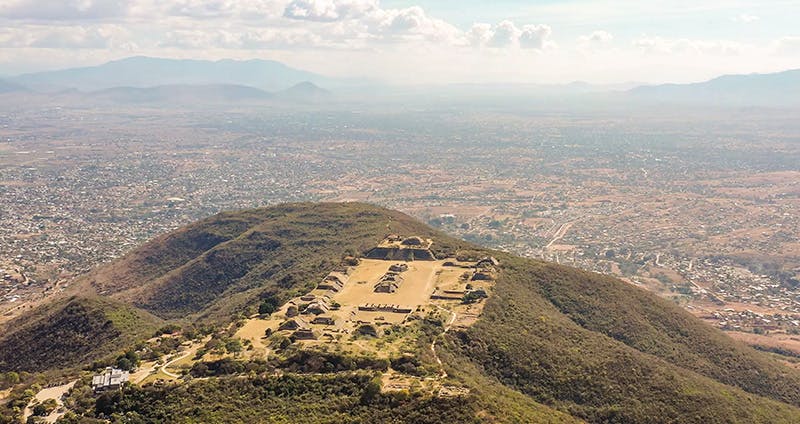
– Preclassical Period –
In the Middle Preclassical Period (roughly 1,500 – 700 B.C.E.), the nearby archaeological site of Monte Albán was the seat of power. It was a thriving city with a multiethnic population consisting mostly of Zapotec and Mixtec peoples. However, considering their close ties with Teotihuacanos, it’s likely many other peoples resided in the area.
Though as a city, the site of Monte Albán was abandoned in the 9th Century, the mountaintop settlement continued to be used for religious and ceremonial rituals by the Mixtec people through the Postclassical Period.
– Arrival of the Aztecs –
In the late 15th Century, during a time of upheaval in the region—when Mixtecos were warring against the feuding Zapotec city-states Yagul, Lambityeco, Tehuantepec, and Zaachila—the Aztecs arrived to conquer the region. The king of Zaachila died at the Battle of the Cerro de Giengola. however, both sides favored a truce, leading to peace between the Aztecs and the Zapotecs.
A marriage of conciliation was arranged between the new king of the Zapotecs, Cocijoeza, and the Aztec emperor’s daughter, Coyolicatzin. To celebrate their nuptials, the Aztec Emperor ordered the founding of Huaxyacac (pronounced wa-ya-cac). In the Nahuatl language, this means “among the huaje trees.” (Hauje trees, endemic to the region, are known as river tamarinds in English.) The edible seeds of the huaje tree were an important source of protein and fiber. From this phrase, we get the name Oaxaca.
It was at this time that the foundations for the current site of Oaxaca City were set. Thus, it’s in this sense that Oaxaca City is seen as a continuation of Monte Albán—where the Zapotec and Mixtec peoples have continued to reside and thrive for millennia.
– Colonial Period –
Hernán Cortés sent Francisco de Orozco to Oaxaca to lay the foundations for the conquest of the region. He arrived on November 25th, 1521, accompanied by 400 Aztec warriors. Cortés had a special interest in conquering Oaxaca because the Aztec ruler Moctezuma II had told the conquistador that Oaxaca was where the Aztecs got their gold.
Orozco’s Spanish envoy took over the stronghold of Huaxyacac, (pronounced wa-HI-a-cac), which had been built two generations prior. They renamed the location “Guajaca” which was a Hispanization of the Nahuatl name. It would later be spelled as Oaxaca.
Since then, it had become an Aztec military post to preserve their rule during yet another war between the Zapotec and Mixtec peoples. Here, a Chaplain named Juan Díaz would give Oaxaca’s first Catholic mass under a large huaje tree. This would become the site of the Church of San Juan de Dios.
From the beginning, Cortés wanted to control this region. He sent Pedro de Alvarado—a ruffian conquistador who would eventually become the governor of Guatemala—to kick out the villagers from Orozco’s expedition. The villagers retaliated by appealing to the Spanish crown to have their village recognized, which it was in 1526.
Three months later, Cortés again forced out all the villagers from Orozco’s original expedition, and he replaced them with his own cronies (including all of the town council). The original villagers then appealed to Nuño de Guzmán, the Spanish viceroy in Mexico City. He too, sided with the original villagers, and they were able to reestablish the town in 1529 under the name Antequera in honor of Nuño de Guzmán’s hometown. (It would be called Antequera for the next three centuries until the Mexican Independence from Spain.)
However, during that time, Hernán Cortés had maneuvered to gain the title Marquis of the Valley of Oaxaca, which made him the ruler of all the pueblos in the terrain. He maneuvered to make the surrounding villages hostile to the settlement of Orozco’s villagers.
To counter this, Orozco’s villagers petitioned the crown to be recognized as a city that would grant them certain rights as well as being under the direct control of the Spanish crown—not Cortés in his position as Marquis. In 1532, King Charles V of Spain granted Oaxaca City status as a city.
Oaxaca City in Mexican History
In 1812, Oaxaca was one of the first regions to be liberated from Spanish rule. It was there that José María Morelos first received the revolutionary document Constitutional Elements which had been drawn up by Ignacio López Rayón. Morelos would leave shortly after to begin his march toward Acapulco, but the loss of Oaxaca was a massive setback to the Spanish government.
In 1821, Oaxaca City became the seat of a municipal government, and both the city and the municipality were named “Oaxaca” as a symbolic gesture of the return of rule to the people of the region.
Oaxaca City in Modern History
In 2005, Oaxaca’s new authoritarian governor Ulises Ruiz Ortíz ordered the assassination of 36 activist leaders, as well as banning political demonstrations in the capital’s historic center, el Zócalo.
In May of 2006, the national teachers’ union staged an annual occupation of el Zócalo. This had been a tradition, a largely symbolic gesture that was done every year, and a negotiation tactic to lobby for better conditions and salaries for education staff.
This year, the protests drew far larger crowds than ever before. The government announced plans for increases in wages and employment benefits. However, many in the teacher’s union accused the heads of the union of making “backroom” deals that went contrary to the position of the union. Several teachers remained on strike, sleeping in el Zócalo.
The night of June 14th, the Oaxacan state police tear-gassed and assaulted the teachers still on strike in el Zócalo—which enraged the local indigenous population and their private militias.
Many radical groups merged with the teachers’ union to form the APPO (Popular Assembly of the People of Oaxaca). This assembly sought to defend the rights of the common citizenry against what they called “death caravans”, Gestapo-style police squads that patrolled the city.
That year, the APPO closed government facilities, barricaded access to the city, and replaced the city’s police force with a local indigenous militia called the Honorable Cuerpo de Topiles. (Topiles are essentially indigenous sheriffs.)
In October of 2006, then Mexican President Vicente Fox sent over 10,000 paramilitary troops into Oaxaca City to take it back under government control. The ensuing violence resulted in the death of many prominent activists and journalists. By late December, the government had retaken control of the city, though grassroots radicals continue to clash with local and state governments to this day.
Climate
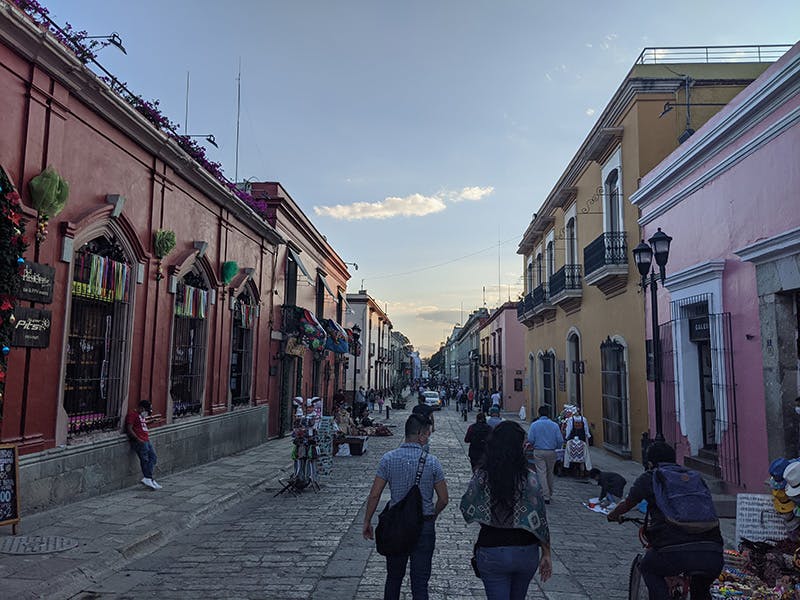 The climate in Oaxaca City is known as a “tropical savanna climate”. Due to its high altitude, it just barely falls under the classification of a humid subtropical climate though it is known for being very humid.
The climate in Oaxaca City is known as a “tropical savanna climate”. Due to its high altitude, it just barely falls under the classification of a humid subtropical climate though it is known for being very humid.
The warmest season is the dry season between the months of December and May, but in the early months of the dry season, it stays relatively cool (with roughly a daily high of 27 ℃, 80 ℉), but at nighttime, it falls to an average temperature of 9 ℃ (48 ℉).
This temperature climbs dramatically during the end of the dry season to an average temperature of 33 ℃ (92 ℉).
– Rainy Season of Oaxaca City –
Oaxaca City is blessed with the tropical summer rains that cool down all of central Mexico. This drastically brings down the average temperature to about 22 ℃ (72 ℉). During this period, the nighttime low temperatures also raise to a comfortable 15 ℃ (60 ℉)—making this period an ideal time to travel through the state of Oaxaca. However, you can expect a daily average of 5” – 7” of rain during the rainy season.
Getting to Oaxaca City
In recent decades, getting to Oaxaca City has become easier—though it’s still more difficult than other, more developed areas in Mexico.
– Flying to Oaxaca City –
Oaxaca City has an international airport, though the airport is small with only one terminal handling all their domestic and international flights. Occasionally, you can find international flights to Oaxaca City from Los Angeles, Houston, and Dallas/Fort Worth, but their direct routes between Chicago O’Hare have recently been suspended. Thus, most international flights will route you through Mexico City.
The largest Mexican cities will have direct domestic flights to Oaxaca City. However, even smaller, prominent cities have to be routed through Mexico City first.
– Driving to Oaxaca City –
Driving to Oaxaca City can be quite challenging. In the 1980s and 1990s, a tourism explosion and interest in Oaxacan culture led to the development of the Oaxaca-Mexico City Highway 135D in 1994, which connects Mexico City through Puebla to Oaxaca City. The drive from Mexico City takes 6 and a half hours under ideal conditions.
Unfortunately, there can be difficulties driving through rural Oaxaca because several of the tolls have been commandeered by local indigenous militias. According to reports from expats, during the covid-19 pandemic, several of these smaller toll booths are not allowing anyone but locals to cross through their region (depending on how dire the situation is at that time).
Therefore, the most reliable route to drive to Oaxaca City during the covid-19 pandemic is via the coastal route and then cutting inland from Puerto Escondido. Depending on where you begin your journey, it can be dangerous—especially if you cross the state of Guerrero. It is also an arduous journey through the treacherous mountain passes of Oaxaca, therefore we highly recommend that you simply fly to Oaxaca City.
– Getting to Oaxaca City by Bus –
There are several bus lines that are running to Oaxaca City from nearby cities, such as Puebla, Veracruz, and Puerto Escondido. To find bus routes that would carry you to Oaxaca City, Rome 2 Rio is a wonderful place to begin looking into which bus lines are running and how much they cost.
- Mexico City
Mexico City has several bus lines that run directly to Oaxaca City. The average price ranges from $500 – $900 MXN. It claims to take between 6 and 7 hours, but I would allow more time for delays. ADO is the most prominent bus company running these routes.
- Puebla
Puebla has direct buses that run right to Oaxaca City between $400 – $700 MXN. The trip takes 4 hours and 40 minutes—though I would personally allow time for delays.
- Veracruz
Veracruz has buses that run to Tehuacán which costs $300 – $750 MXN. This trip takes roughly 4 hours. Then once in Tehuacán, you can take a bus for another 3 hours to Oaxaca City, which costs between $300 – $400 MXN.
- Puerto Escondido
Puerto Escondido has a bus route that runs to Oaxaca City, however, it is not direct. It is a 10-hour journey that has three stops in other smaller cities on the way. The average price is between $550 – $800 MXN. This bus route is one of the most unpleasant experiences you can hope to have on a bus. Between blind hairpin turns and loud, dangerous oncoming traffic, expect little relaxation and zero sleep on this route.
Food and Drink
 Oaxaca City is one of the most prominent culinary hotspots in all of Mexico. It is most famous for its multitude of regional mole sauces, many of which can only be found in the state of Oaxaca.
Oaxaca City is one of the most prominent culinary hotspots in all of Mexico. It is most famous for its multitude of regional mole sauces, many of which can only be found in the state of Oaxaca.
– Moles in Oaxaca City –
Though several moles found in Oaxaca can also be found in the rest of Central Mexico—such as mole rojo (often called mole colorado in Oaxaca) and mole verde—this guide will focus on two regional moles that are native to the state of Oaxaca.
Mole negro (“black mole” in English), also called mole oaxaqueño, is the most complex type of mole sauce found in all of Mexico. It can involve delicately combining 32 or more different ingredients, sometimes over the course of days. It is characterized by having a very dark color (near black), and it is notorious for often being one of the most bitter moles—and it can be quite spicy. It is stereotypically inedible to foreign palates, though any trip to Oaxaca City should involve a taste of mole negro for the adventurous culinary traveler.
Mole amarillo (“yellow mole” in English), often referred to solely as amarillito in Oaxaca, is one of the rarest moles in all of Mexico. This is because, traditionally, this mole is made with a pepper called "chilhuacle amarillo". Due to climate change and monocropping, this chile is slowly becoming extinct. Most mole amarillos now employ a combination of chiles guajillo and pasilla, which approximate the color and flavor of the traditional mole. But if you can find someone with an original amarillito, then you should take advantage of the opportunity. It is typically not spicy, and it is sometimes served with rabbit instead of the most common protein: fowl.
– Chocolate in Oaxaca City –
Oaxaca is known for the production of some of the highest quality chocolate on the planet. Often, these bars of chocolate are bitter which are used in cooking savory dishes like mole oaxaqueño.
That said, bars of sweetened and semi-sweet chocolate are also available for use in making Oaxacan-style hot chocolate. These bars can sometimes be seasoned with spices like cinnamon, clove, and almonds. This drink is often served in a traditional clay mug with no handle and accompanied with pan de yema, which is a type of bread made with egg yolk.
– Cheese in Oaxaca City –
A variety of artisan cheeses can be found in Oaxaca, though the most famous regional cheese is queso oaxaca (simply called “quesillo” in Oaxaca). Very similar to a string-cheese mozzarella, this semi-firm, salty cheese melts under high temperature, though it quickly cools—unlike, say, a runny queso chihuahua that more closely resembles a Monterey Jack. You can expect most street vendors selling quesadillas to employ quesillo, the local, regional cheese.
– Tlayudas in Oaxaca City –
A tlayuda (occasionally called a “clayuda”) is a regional Oaxacan dish that is often referred to as a “Mexican pizza” by Western travelers. It starts with a corn tortilla that has been rolled out very large and thin. It can then be fried or toasted on a comal—a traditional cast-iron skillet used in Mexican cuisine.
Then a thin layer of refried beans is spread over the tortilla. This creates a base for the tlayuda. Quesillo (or queso oaxaca) is added along with shredded meat (chicken, pork, or beef tenderloin and it is heated to melt the cheese. Finally, lettuce or cabbage and salsa are added to the dish creating what one might call a “Mexican pizza”. If you’re in a restaurant, it’s served as such, but if you’re at a street food stand, then the tlayuda will be folded into quarters making it easier to carry and eat on the run.
What to do in Oaxaca City
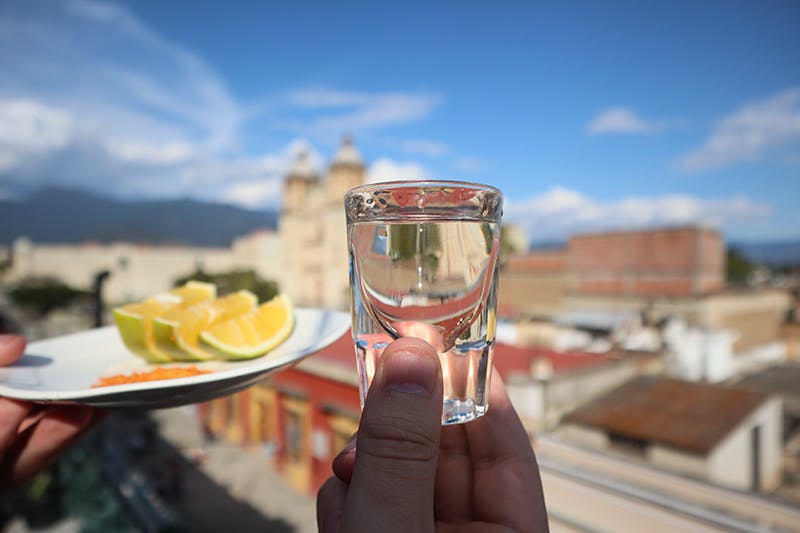 Oaxaca City is a really fun city to explore with all kinds of events, tours, and landmarks to experience. This tourism explosion has created an avenue for oaxaqueños to showcase their spectacular culture and culinary delights—all while demonstrating the genuine and welcoming nature of the people of Oaxaca.
Oaxaca City is a really fun city to explore with all kinds of events, tours, and landmarks to experience. This tourism explosion has created an avenue for oaxaqueños to showcase their spectacular culture and culinary delights—all while demonstrating the genuine and welcoming nature of the people of Oaxaca.
– Landmarks in Oaxaca City –
As you may have read in previous sections above, Oaxaca City lay largely isolated from the rest of Mexico for most of the last several centuries. It was not until the creation of the Oaxaca-Mexico City Highway 135D in 1994 that it fully became accessible to a thriving tourist industry eager to explore this rich, untouched land. For this reason, Oaxaca City boasts a multitude of impressive landmarks that support a thriving tourist industry.
Monte Albán
One of the chief archaeological attractions in all of Mexico, Monte Albán is an impressive pre-Columbian site. It was the ancient capital of the Zapotec people—reaching its height between 500 BCE – 800 CE (a span of 1,300 years). At its peak, it held 35,000 residents.
This archaeological site is partially excavated, with hundreds of artificial terraces, dozens of tels (unexcavated architectural mounds), and an impressive excavated pyramid complex on par with any in Mexico.
Oaxaca Cathedral Institución (El Zócalo)
This is the main square of Oaxaca City. It features stunning colonial architecture, arcades, as well as several government buildings boasting some of the best architecture and decór in Oaxaca City. One of these buildings, The State Government Palace, boasts some of the best murals depicting Oaxaca’s prehispanic history.
In the northwest corner of el Zócalo is the Alameda de León. This garden area was turned into a park in the 1840s, endeavoring to replicate the Alameda Central in Mexico City. It’s a great place to lounge around with locals next to the marketplace, while still taking in the sights of the historical center of Oaxaca City.
Oaxaca Cathedral
Commonly known as Oaxaca Cathedral, its official name is Catedral Metropolitana de Nuestra Señora de la Asunción. Due to earthquakes in the 16th and 18th centuries, the current standing structure is the third construction—the last structure having been completed in 1733. In addition, the towers were reconstructed in 1931 due to structural damage during another earthquake.
Built from the local green cantera stone commonly found throughout Oaxaca, the baroque facade lies in stark contrast to its Neoclassical interior. It features a bronze Italian sculpture of Nuestra Señora de la Asunción, which was made by Tadoini and imported during the Porfiriato. (The Porfiriato refers to the period when General Porfirio Diaz was the Mexican president, between 1876 and 1911.)
Museums
Oaxaca City features many incredible historical and artistic museums that are a great way to learn about the evolution of art and culture throughout history. One of the must-see museums is the Museo de las Culturas de Oaxaca. Located in the Centro Cultural de Santo Domingo, this museum features ten halls and an auditorium specializing in the indigenous peoples of the area—specifically the Mixtec and Zapotec peoples who founded Oaxaca City.
Another is the Museum of Contemporary Art located in the Casa de Cortés. This features some brilliant contemporary collections of works by famed Mexican artists, both in the modern period and today.
For art aficionados, you can’t miss the Rufino Tamayo Museum, which holds an important collection of his personal paintings. In addition, it also has an impressive collection of prehispanic art that the painter acquired for his personal collection.
Lastly, the Museum of Oaxacan Painters is a terrific way to explore art from the most prominent Mexican painters from the state of Oaxaca. It features works by Morales, Nieto, Toledo, Santiago, and other famed artists of the area.
Markets
Perusing markets is a Oaxacan tradition. There are two prominent markets that boast all manner of goods, from edible delicacies and rare ingredients to artisan handmade wares (as well as tons of inexpensive commercial products). The first is Benito Juárez Market, which takes up an entire city block. The second is the Mercado 20 de Noviembre, which is more geared towards food and culinary products.
Tours
Oaxaca City is known for having tours that can take you inexpensively to explore the outlying landscape’s hidden treasures. You can take tours to visit:
- Caves of San Sebastian
- Mitla
- Teotitlán del Valle
- Hierve el Agua (Hot Springs)
- Sierra Juárez
- Ixtlán de Juárez
- Guelatao de Juárez
- Capulalpam de Méndez
- Cuilapam
- Coyotepec
- Arrazole
- Arbol de Tule
Also, you can take some really cool mezcalería tours to see how Oaxacan mezcal is traditionally produced. In addition, after you take the tour, you can purchase some artisan mezcal for great prices so you have something to take with you as a reminder of the amazing experience.
Restaurants and Bars
Oaxaca City is full of incredible bars and restaurants to explore. We’ll only mention a couple.
If you’re interested in a really great restaurant experience, you have to try Casa Oaxaca. This restaurant serves great contemporary Oaxacan cuisine headed by internationally-famed chef Alejandro Ruiz. It’s quite popular, so we recommend getting reservations in advance.
If you’re looking for a unique and awesome bar experience, check out Mezcalogia. This bar features artisan cocktails served by top mixologists in Oaxaca. You can sample the finest artisan mezcals mixed into works of art—each one better than the last.
Rafael Bracho
Insurance Expert & Writer
For several years, Rafael has been crafting articles to help expats and nomads in their journey abroad.
Get Protected While Living Abroad
Found this article helpful? Make sure you have the right insurance coverage too. Get instant quotes for international health, life, and travel insurance.
Takes 2 minutes • Compare multiple providers • Expert advice

